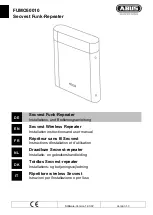
COZY TOP VENT GRAVITY GAS WALL HEATER
5
The following steps are all needed for proper installation and
safe operation of your furnace. If you have any doubts as to any
requirements, check with local authorities. Obtain professional
help where needed. All of the checks and adjustments in the
Start-Up Procedures are vital to the proper and safe operation of
the furnace. Please read the instructions before you install and
use your furnace. This will help you obtain the full value from this
furnace. It could also help you avoid needless service costs if the
answer to the problem is found within this instruction manual.
Always consult your local heating or plumbing inspector, building
department or gas utility company regarding regulations codes or
ordinances which apply to the installation of a vented wall furnace.
Check the furnace nameplate, located in the burner compartment,
to make sure your furnace is equipped to operate on the type of
gas available (either natural or propane gas). DO NOT convert the
furnace from natural gas to propane gas or from propane gas to
natural gas without the proper manufacturer’s gas conversion kit.
Combustion air is drawn in from the room where the furnace
is located and is vented out of the top of the furnace vertically
through vent piping in the stud space to a roof vent top. Vent
material is not supplied with the furnace.
This furnace is equipped with a vent safety shutoff system
designed to protect against improper venting of combustion
products. Operation of this wall furnace when not connected to a
properly installed and maintained venting system or tampering
with the vent safety shutoff system can result in carbon monoxide
(CO) poisoning and possible death.
The efficiency rating of this furnace is a product thermal efficiency
rating determined under continuous operating conditions and was
determined independent of any installed system.
1) Seal any unused openings in the venting system.
2) Inspect the venting system for proper size and
horizontal pitch, as required in the National Fuel
Gas Code, ANSI Z223.1/NFPA 54 or the Natural Gas
and propane Installation Code, CSA B149.1 and
these instructions. Determine that there is no
blockage or restriction, leakage, corrosion and other
deficiencies which could cause an unsafe condition.
3) As far as practical, close all building doors and
windows and all doors between the space in which
the appliance(s) connected to the venting system
are located and other spaces of the building.
4) Close fireplace dampers.
5) Turn on clothes dryers and any appliance not
connected to the venting system. Turn on
any exhaust fans, such as range hoods and
bathroom exhausts, so they are operating at
maximum speed. Do not operate a summer
exhaust fan.
WARNING:
CARBON MONOXIDE POISONING HAZARD
Failure to follow the steps outlined below for each appliance connected to the venting system being placed
into operation could result in carbon monoxide poisoning or death.
The following steps shall be followed for each appliance connected to the venting system being placed into operation, while all other
appliances connected to the venting system are not in operation:
6) Follow the lighting instructions. Place the appliance
being inspected into operation. Adjust the thermostat
so appliance is operating continuously.
7) Test for spillage from draft hood equipped appliances
at the draft hood relief opening after 5 minutes
of main burner operation. Use the flame of a match
or candle.
8) If improper venting is observed during any of the
above tests, the venting system must be corrected
in accordance with the national fuel gas code,
ANSI Z223.1/NFPA 54 and/or Natural Gas and propane
Installation Code, CSA B149.1.
9) After it has been determined that each appliance
connected to the venting system properly vents
when tested as outlined above, return doors, windows,
exhaust fans, fireplace dampers and any other
gas-fired burning appliance to their previous
conditions of use.
INTRODUCTION






































